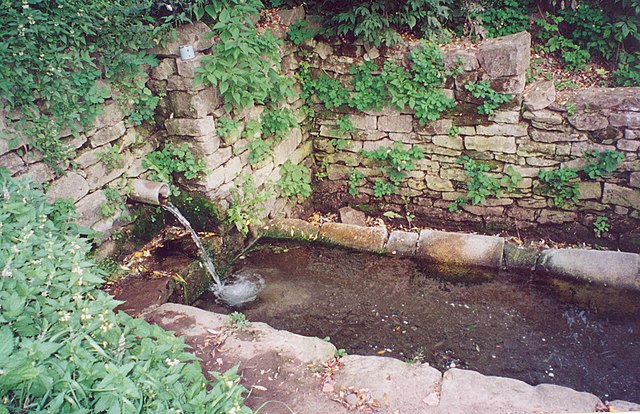Groundwater is the water present beneath Earth's surface in rock and soil pore spaces and in the fractures of rock formations. About 30 percent of all readily available freshwater in the world is groundwater. A unit of rock or an unconsolidated deposit is called an aquifer when it can yield a usable quantity of water. The depth at which soil pore spaces or fractures and voids in rock become completely saturated with water is called the water table. Groundwater is recharged from the surface; it may discharge from the surface naturally at springs and seeps, and can form oases or wetlands. Groundwater is also often withdrawn for agricultural, municipal, and industrial use by constructing and operating extraction wells. The study of the distribution and movement of groundwater is hydrogeology, also called groundwater hydrology.
Dzherelo, a common source of drinking water in a Ukrainian village
The entire surface water flow of the Alapaha River near Jennings, Florida, going into a sinkhole leading to the Floridan Aquifer groundwater
Groundwater may be extracted through a water well
Center-pivot irrigated fields in Kansas covering hundreds of square miles watered by the Ogallala Aquifer
Water is an inorganic compound with the chemical formula H2O. It is a transparent, tasteless, odorless, and nearly colorless chemical substance, and it is the main constituent of Earth's hydrosphere and the fluids of all known living organisms. It is vital for all known forms of life, despite not providing food energy or organic micronutrients. Its chemical formula, H2O, indicates that each of its molecules contains one oxygen and two hydrogen atoms, connected by covalent bonds. The hydrogen atoms are attached to the oxygen atom at an angle of 104.45°. In liquid form, H2O is also called "Water" at standard temperature and pressure.
Water
This pillow basalt on the seafloor near Hawaii was formed when magma extruded underwater. Other, much older pillow basalt formations provide evidence for large bodies of water long ago in Earth's history.
Specific heat capacity of water
High tide








